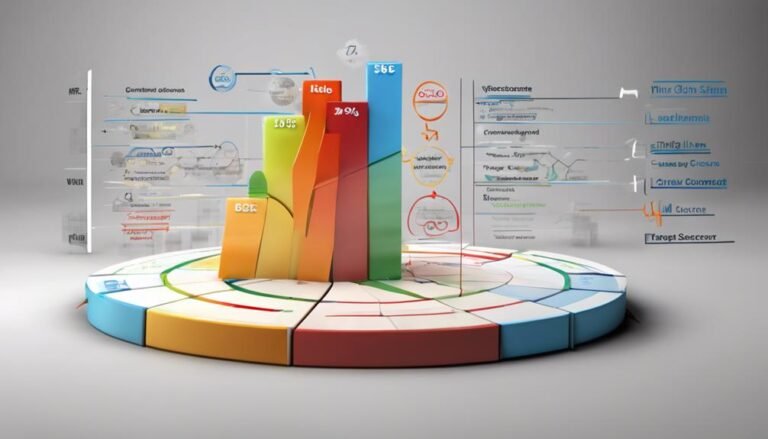Conflict of Interest Explained: Types and Examples
Conflicts of interest occur when personal interests conflict with professional duties, risking trust and integrity in business. Examples include self-dealing, favoring personal gain over company interests, and nepotism in hiring. Legal consequences can lead to job loss and damaged reputations. Different types of conflicts arise when personal interests clash with professional responsibilities in business settings. Clear policies, training, and open communication help prevent and address conflicts effectively. Understanding conflict of interest types and examples is essential for maintaining ethical standards and corporate governance. Further insights can uncover diverse perspectives on managing conflicts within organizations.
Key Takeaways
- Conflict of interest involves personal interests conflicting with professional duties.
- Examples include self-dealing, nepotism, misuse of confidential information, and gift issuance.
- Legal implications include job loss, legal issues, and damaged reputations.
- Types of conflicts in business include ethical dilemmas and self-serving behaviors.
- Prevention strategies include clear policies, training, and transparent communication.
Conflict of Interest Definition
In the domain of professional ethics and corporate governance, the concept of conflict of interest is a pivotal principle that underscores the importance of maintaining a clear boundary between personal interests and professional obligations.
Understanding implications is essential as conflicts can arise when personal interests diverge from the responsibilities one holds in a professional capacity. This conflict may lead to decisions that favor personal gain over the organization's best interests.
Recognizing and addressing these conflicts is vital to uphold integrity and trust within the business environment. By being vigilant and proactive in identifying potential conflicts, individuals can mitigate the risks associated with such situations, ensuring that their actions align with the ethical standards expected in their roles.
Examples of Conflict of Interest
Examples of Conflict of Interest can be observed in various professional settings where personal interests intersect with professional responsibilities, potentially leading to ethical dilemmas and compromised decision-making. Maintaining professional integrity in such situations is essential. Below are some common examples of conflicts of interest:
| Conflict Type | Description | Example |
|---|---|---|
| Self-Dealing | Prioritizing personal gain over company interests | A purchasing manager awarding contracts to a family member's business |
| Financial Advisors | Advising for personal gain rather than client's best interests | Recommending investments that benefit the advisor's financial portfolio |
| Nepotism | Showing favoritism towards relatives in hiring or promotion decisions | Hiring an unqualified family member for a position |
| Gift Issuance | Accepting gifts from clients that may influence decision-making | Receiving expensive gifts from potential business partners |
| Misuse of Confidential Information | Using privileged information for personal advantage | Trading stocks based on non-public company information |
These examples illustrate the complexities that can arise when personal interests conflict with professional responsibilities, highlighting the importance of handling such situations with care to uphold professional integrity.
Legal Implications and Consequences
Legal ramifications associated with conflicts of interest can have far-reaching consequences for individuals and organizations alike. Ethical dilemmas arise when personal interests interfere with professional duties, leading to potential legal repercussions.
Individuals facing conflicts of interest may be required to recuse themselves from decision-making processes to maintain transparency and integrity. Failure to address conflicts of interest can result in job loss, legal issues, damaged reputations, and financial penalties.
Organizations must establish clear policies and procedures to identify, prevent, and mitigate conflicts of interest to uphold ethical standards and avoid the negative impacts that can occur. It is essential for both individuals and entities to navigate conflicts of interest with caution to avoid the detrimental effects that can arise from such situations.
Types of Conflicts in Business
Various conflicts can arise in business settings due to conflicting personal interests and professional responsibilities. In the domain of business, ethical dilemmas often emerge, challenging individuals to navigate fiduciary responsibilities and make ethical decisions.
These conflicts can manifest in various forms, such as self-dealing, where one benefits themselves at the expense of the company or clients, gift issuance by accepting gifts from clients, misuse of confidential information for personal gain, nepotism in favoring relatives in hiring or treatment, and financial advisors prioritizing personal gain over clients' interests.
Corporate governance plays an important role in addressing and preventing these conflicts, emphasizing the importance of ethical decision-making to safeguard the integrity of business operations and relationships.
Prevention and Addressing Strategies
Effective management of conflicts of interest in professional settings requires proactive implementation of prevention and addressing strategies. Ethical dilemmas can arise when personal interests interfere with professional responsibilities, necessitating proactive measures to prevent such conflicts.
Establishing clear policies and guidelines regarding conflicts of interest, providing regular training sessions to raise awareness, and encouraging open communication are essential preventive measures.
Addressing perceived conflicts promptly and transparently, disclosing potential conflicts when they arise, and recusing oneself from decision-making processes when necessary are crucial steps in managing conflicts of interest.
Conclusion
To sum up, conflicts of interest present a complex web of ethical considerations that can impact professional integrity.
Similar to a tangled labyrinth, maneuvering through these conflicts requires a keen awareness of personal motivations and fiduciary duties.
By proactively identifying and addressing potential conflicts, individuals and organizations can cultivate a culture of transparency and trust, safeguarding against the pitfalls of self-interest and preserving the foundation of ethical conduct.







